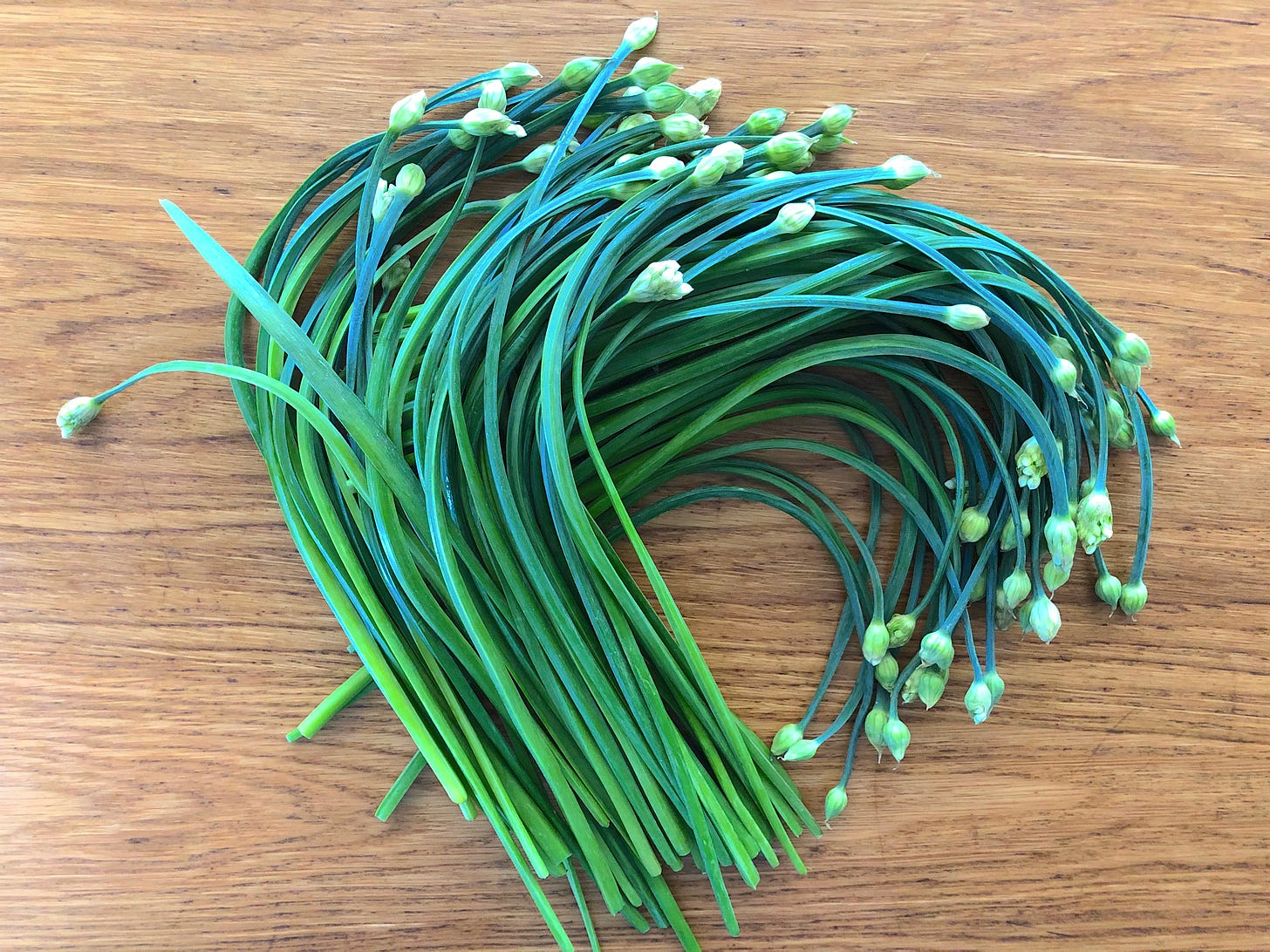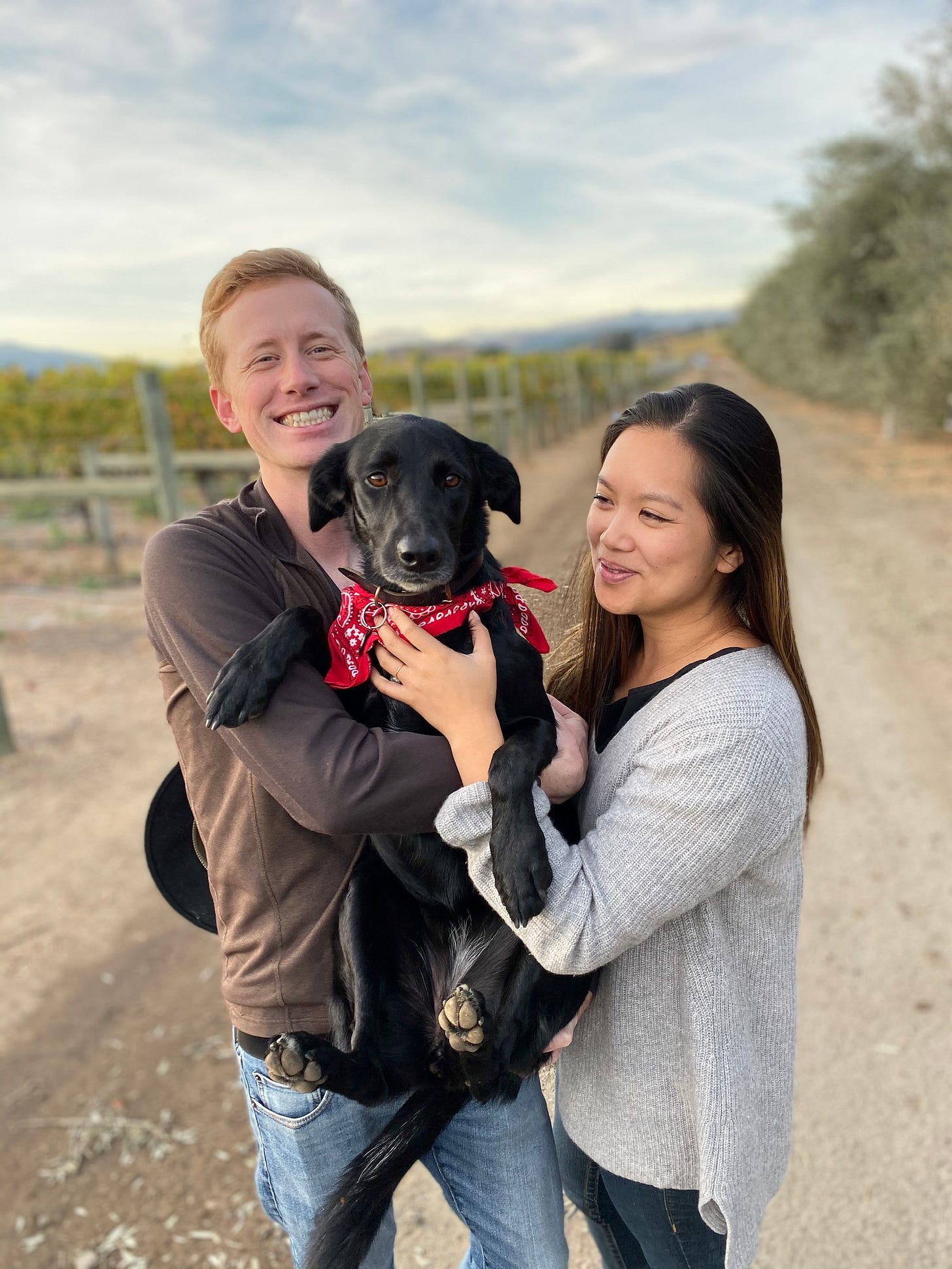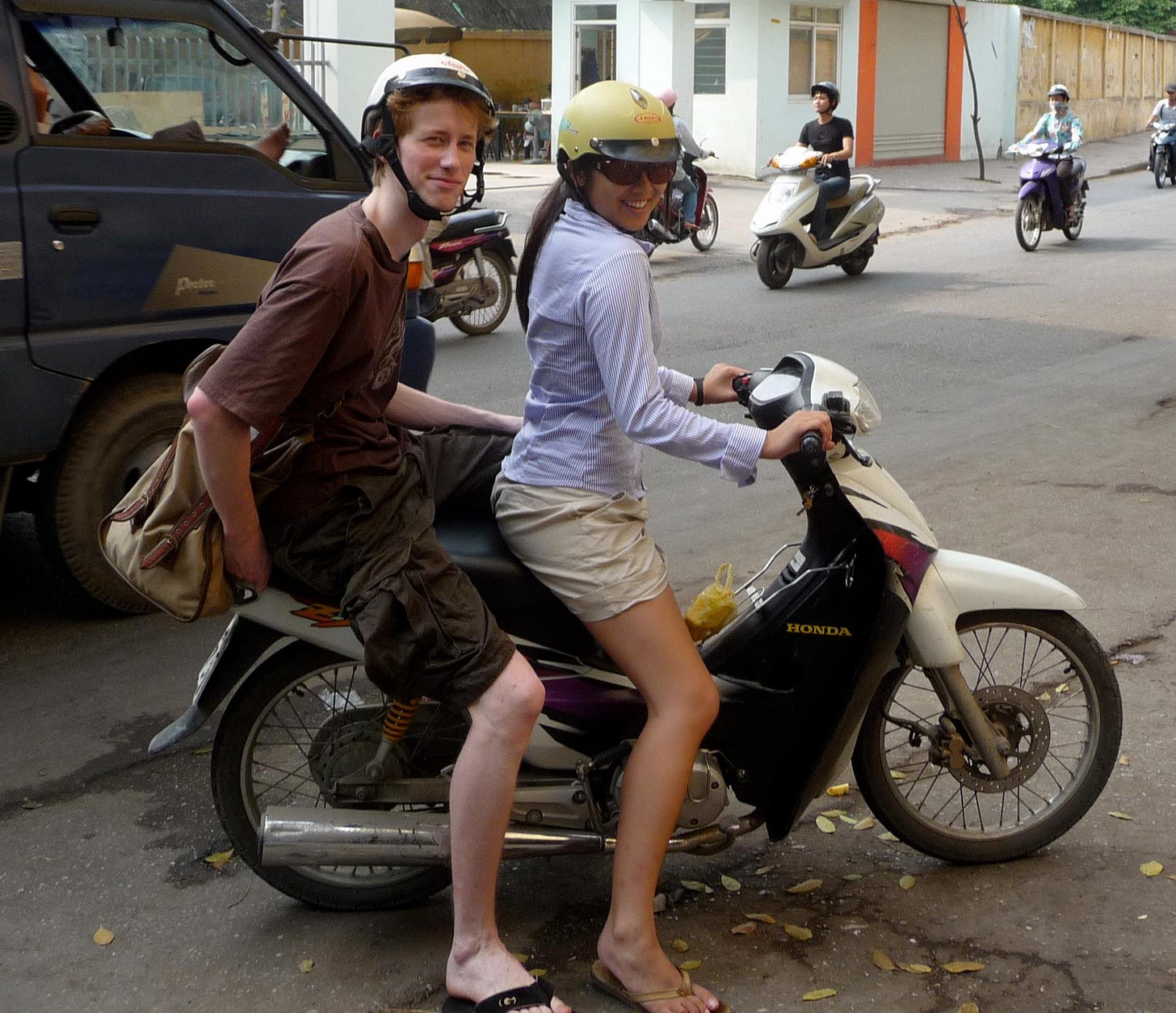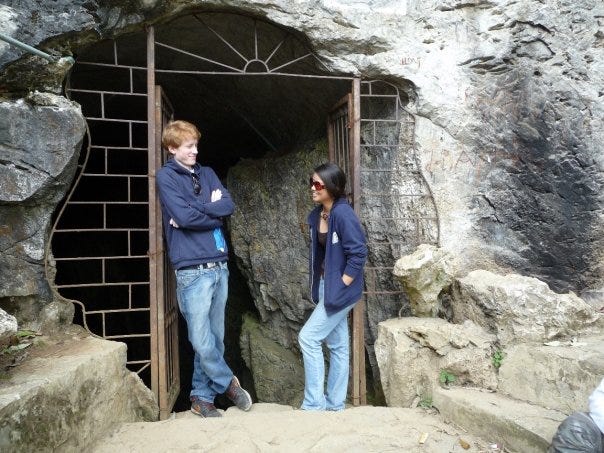Happy Saturday! I was so thrilled to see such great responses to the first recipe from the California Breakfasts series. I’ll send out another breakfast recipe next week (a beautiful egg dish that Fanny Singer and her mother, Alice Waters, make). But first, we’re returning to our regular interviews, which explore the wide range of foods made by home cooks all across California.
Today I’m sharing an interview with Candice Nguyen, a Vietnamese-American lawyer who spent much of her childhood in California (and also makes lovely tableware), and Jelmer Tiete, a Belgian engineer. When we spoke last year, the two told me about how making meals together and moving to California a few years ago has changed their cooking. They also shared a wonderful recipe for a simple stir-fry of flowering garlic chives that is a fantastic side for pretty much any dish you can think of.
Before we dive in, however, a little housekeeping: I’ve recently turned on paid subscriptions. I don’t yet offer subscriber-only content, but I will once the list has grown. In the meantime, the paid option is essentially a donation to help cover the cost and time of doing these interviews, testing recipes, taking photos, etc. If you’re interested in contributing, you can change your subscription settings here.
Candice Nguyen and Jelmer Tiete
The California Table:
Can you tell me a bit about your backgrounds and what the food you cook is like?
Candice:
I am a first generation Vietnamese American. I grew up in Southern California and Michigan, but I lived all over the world, including in Vietnam, as an adult—that’s actually where Jelmer and I met.
I grew up in a very white space with limited access to Asian supermarkets, especially in the Midwest, when we were in the Detroit suburbs in the late 90s and 2000s. We had to adapt and create this Vietnamese American cuisine, which is quite distinct from Vietnamese food. So, I grew up eating almost entirely home-cooked meals—and I continue to do that now.
Jelmer and I cook basically every day and we’re becoming even more fusion, because Jelmer’s from Belgium. So our food is always evolving. But my cooking tends to be very rooted in Vietnamese everyday cooking.
By way of background, the Vietnamese diaspora that comes to the United States is very, very diverse in many ways, including socioeconomically. I see that with my own family. My mother’s family was extremely poor. They were farmers. My father’s family was upper-middle class, from all over Vietnam, because the way the war broke down, it kind of moved Vietnam internally before people emigrated to other countries. So, my food, I think, is a really interesting historical capsule of that movement over time.
We always joke that my cooking is farmers’ food. You learn how to stretch protein a thousand different ways. It’s also very plant based, with some fish sauce.
Jelmer:
I grew up in Belgium, and I only came to the US a few years ago. Before that, I’d always lived in Belgium.
Belgians in general don’t really reach out that much, foodwise. They usually stay with their traditional Belgian food. But I was very lucky that my father’s a pretty good cook, and he makes non-traditional Belgian things. So, it will have influences from Malaysian or Indian—all sorts of cuisines, basically. That’s where I got a better taste of different cultures’ cooking. My mom is not that adventurous a cook, so most of my tastes came from my dad. He never really taught me; it’s not like I cooked next to him. It’s basically just from eating his food that I figured out what tastes good, what works well together. Once I moved out of my parents’ house, I started cooking myself. In Belgium, there is no eating-out culture, so you just make your own food every night.
About 10 years ago, I met Candice, and since then we’ve been cooking together. And since then, there has also been a way bigger Vietnamese influence, obviously, in my cooking.
As Candice mentioned, we lived in a lot of different places. The first place where we lived for a long time was Belgium, and that was where I really adapted my day-to-day cooking to Candice’s taste. Before, I ate a good amount of Vietnamese food, of course, but that’s when I started discovering the different flavors that show up in various dishes and how those dishes are prepared.
After that, we moved to the US, and I started cooking more American food—or things that are seen as more traditional American, I guess. It came out of curiosity but also out of need, because a lot of the Belgian dishes that I make, I couldn’t really find the right ingredients here. The meat just tastes different. And Belgian food is very heavily meat based. It’s very hard to find good pork here, for instance, or veal. And if you don’t have that base, it’s very hard to make those dishes. So, out of necessity, I started exploring more traditional American food, where the ingredients were readily available. And then also, of course, I was still making a lot of Vietnamese food.
Then we moved to California, and here, again, there’s way more Asian influence, way more Asian food available. So we’ve been cooking a lot of Asian food. We also live a lot closer to Candice’s parents, so they come over a lot more. I also see what they cook and what Candice really likes, so that’s also really interesting, a really big influence.
Candice:
We also eat less meat, which I think has been a really huge, transformative experience for home cooking.
Jelmer:
Yeah, about a year ago, we decided that we should transfer to going to vegetarian during the week, which was also a very, very big change, because all the dishes that I make are based on meat, basically. So that forced me to get out of the comfort zone and look at local ingredients and dishes that are made without meat. And Asian cuisine—and definitely Vietnamese cuisine—lends itself better to vegetarian dishes, because there’s a lot more vegetarian dishes in Vietnamese cuisine.
I really like discovering new cuisines and new dishes and what they’re supposed to taste like and then trying to recreate those tastes. But living in the U.S. now for a good amount of time, I also miss Belgian food extremely. It’s really hard to find Belgian restaurants. There’s basically none that I can think of in the Bay Area. So I’ve also been trying to recreate a lot of dishes here with the local ingredients available. If ingredients are not available, I’ve tried to tweak recipes to try to find the exact same taste that I remember from home.
The California Table:
What would you say are the most common dishes in Vietnamese American communities here? The ones that every cook living in California would make regularly?
Candice:
The first thing that comes to mind is canh. Canh is just a very simple soup. Every single Vietnamese family will have this on the table almost every single night. It’s super simple, and you can kind of rev it up or down, depending on how complex you want it to be. It can be plant based and or plant-and-meat based, but the basic elements are a broth, a vegetable (often a leafy green, but you can adapt), and then you can throw in literally anything. It can be cubes of meat, or I like to do sort of fish or shrimp balls that you make in a food processor, for instance. It’s so overlooked, but it’s so important and homey and amazing. Every family does it slightly differently. It’s so malleable and interesting and delightful.
And second are your noodle soups. You have your front runner, which is pho. Then there’s bun bo hue. Bun bo hue is from Hue, which is where my father’s family is from. Those are your sort of two star noodle soups. And their broths are completely different. The spices that you put in pho are completely different than the spices that you put in bun bo. The noodles are different, the meat is traditionally pretty different; bun bo is both beef and pork based, and pork should never, be in pho, ever.
Another really typical dish—and it’s not really a dish as much as a technique that you can adapt, which makes it fun—is called goi cuon. I think some people call it summer rolls. It’s the rice paper-based roll that you pack with lots of vegetables and herbs. What I like about it is it’s so adaptable, because once you have the basics (the rice paper, a peanut-hoisin dipping sauce, and your veg and herbs) you can put whatever you want. It’s a very typical leftover meal, honestly, because if we’ve made a lot of protein and we didn’t finish it all, we’ll do goi cuon the next day and just throw it into your summer rolls, wrap it up, and eat it that way. Things that traditionally go into summer rolls are, I think, boiled or sautéed shrimp and pork, but you could do lemongrass tofu or lemongrass chicken, you could do fish—you could do anything you want.
Jelmer:
It’s also a way to get rid of leftover herbs.
Candice:
Right, right, right. That’s true. Certain Vietnamese dishes are very particular about what sort of herbs you put in them, but the nice thing about goi cuon is there are no rules.
Another dish that’s also more of a technique is a clay pot. You caramelize onions with like some sugar and some ginger, and then you put a protein in it, you sear it, and then you bake it slowly in a clay pot. Traditionally that will be catfish (or any sort of fish, but catfish is the most popular) or a dark cut of chicken. It’s super complex but easy to make, especially if you have a good rock sugar, which is essential in Vietnamese cooking.
And I think bun is also very popular, the vermicelli rice noodles. Honestly, I see that as a riff of goi cuon. Instead of rice paper, you have the bun (the rice noodles), and you then add protein and shred in vegetables and eat it that way. And, again, it can be any protein. And the sauce is different. That’s really the only difference between goi cuon and bun in my mind. You change the rice medium, and you change the sauce. The other elements are basically the same.
In a traditional Vietnamese dinner, there’s a heaping pot of steaming jasmine rice. And you always have at least one, if not multiple, vegetable dishes. Almost all Vietnamese vegetable dishes are sautéed in the same way, which is just fish sauce and pepper—and sometimes adding onion and garlic to it. Sometimes hoisin. So that’s it. It’s very simple. There’s also always a pickle dish, like as a side plate of pickled vegetables. You’ll have your protein, and then your can [soup].
The California Table:
Jelmer, what dishes have you been able to recreate at home?
Jelmer:
The most important thing are the Belgian staples. Most Belgian dishes—at least the comfort food dishes—are eaten with fries. Fries are extremely important. But it’s very hard to explain this to, for example, the standard American, because we’re very picky about them. We make them in a very specific way, and we think that way is the right way.
Candice got me a deep fryer, which is something that most Belgian people have at home but is not very common in the U.S. In Belgium, you would traditionally just buy frozen fries and then deep fry them at home. It’s only on special occasions that you would actually buy the potatoes, peel them, cut them. It’s something that you would do for Christmas. But I can’t find the right fries in the U.S., so I have to make them.
Also, with fries we eat a lot of different sauces. In the U.S. that’s usually just ketchup, but we have, like, a million other sauces that are basically based on mayonnaise mixed in with other things.
Vol au vents is an important dish. It’s chicken, basically, with veal meatballs with a white, creamy sauce, served in a tiny puff pastry basket kind of thingy, with fries. It’s extremely rich.
And the second important dish would be stoofvlees, which originated, I guess, from French cuisine. It’s slow-cooked beef in a dark rich sauce. It’s traditionally also eaten with fries or mashed potatoes or croquettes (which are also very hard to find here). It’s a tougher cut of meat cooked very slowly for a couple hours, and then you put some specific ingredients in there. The sauce is usually a dark Belgian Trappist beer, and then you put also a piece of bread in there to thicken it up, and then a sugary syrup thing—that you normally put as a condiment on bread—you put some of that in there to sweeten it. It’s a very sweet and savory, rich stew, basically.
Sometimes I make waffles. In the U.S., people think Belgian waffles are Belgian, but they’re not Belgian in any way. We never eat waffles for breakfast. That’s crazy. There’s also different types of waffles. I actually make the American waffles here more than the Belgian ones.
I also sometimes make pancakes. You have the American pancakes, with are fat stacks of dough, basically. And then the Belgian ones, which are similar to French crepes. Those we do eat for breakfast. So, some days, I think Am I feeling American today, or am I feeling Belgian today? and I make the very thin crepes or the thicker American ones.
California Table:
What foods have the two of you adapted or changed after living in California and cooking together, from your two traditions, for so long?
Candice:
Something that I find funny is that I have all these rules that I grew up with for making Vietnamese food, and Jelmer’s always pushing me, like, “Why can’t we do that?” So he’ll do things that I think are blasphemous and totally crazy, but sometimes it really works! (Other times it does not work, but sometimes it does.)
Jelmer:
It also goes the other way, basically. When Candice puts something weird on some Belgian dish that’s not supposed to be there, and then she tells me, like, “Why?”
Her family is also very proud and very protective of Vietnamese dishes. And there’s certain rules that you have to follow. So, I always very gently try to push…
Candice:
Push the boundaries.
The more fusiony dishes are riffs off the classics. So, for example, with goi cuon, which is traditionally just served with shrimp and pork, we’ll Californiafy it by adding avocado—which, again, is like crazy talk to the Vietnamese person. And then, as I said, we’re trying to eat more plant based, so we’ll make a lot of tofu, and we’ll put tofu and avocado in the goi cuon, which is pretty unusual; traditionally, no Vietnamese person would do that.
I think Jelmer does a lot of fusiony things. One of the things he did recently is a version of this Vietnamese food that is almost like a rice cake pizza. You take rice paper, which you normally soak and roll, but instead, you flash soak it or spritz it or something (Jelmer makes it, I don’t), and you basically make it into a pizza. You cook it—ideally on an open flame, but you can also just fry it on the stove—and you add some protein to it, and different sauces. And it’s friggin’ delightful. I had never had it, and he just kind of saw it in Vietnam and riffed it.
I think that our fusion food tends to be when he’ll make some more European-style protein that I will then take and put into a Vietnamese dish. That’s pretty common. Again, we don’t eat a lot of meat, but when we did eat more meat, he made a batch of stoofvlees (the Belgian stew), and then we had that in a taco. Or you can grill Vietnamese meat and put that in a taco. We eat a lot of tacos. We also love Mexican food, so that’s a pretty common fusion thing too.
Stir-Fried Garlic Chives with Fish Sauce
1 large bunch flowering garlic chives
Vegetable oil
2 cloves of garlic, minced
2 teaspoons fish sauce
Black pepper
Trim the ends of the garlic chives, then cut them into 2"-long pieces; separate the tender tops (with the buds) from the firmer stem end pieces.
Coat the bottom of a pan with oil, and heat it on high. Put the bottom (firmer) pieces of the garlic chives into the pan and cook them for 30 seconds, stirring occasionally. Add the remaining pieces of the chives, and continue to cook, letting the chives brown against the bottom of the pan a bit, until they are very bright green, another 30 to 45 seconds.
Add the garlic to the pan and stir everything for a few seconds, then add the fish sauce. Cook the mixture, stirring, for about 90 seconds. Season the greens generously with pepper, and stir everything together for about 30 seconds before removing the pan from the heat.
Serve the greens hot, as a side to other Vietnamese dishes (or any other main), along with rice.
More California Stories to Read, Watch, and Listen to
Trying to figure out what to cook for the last days of summer? KQED has a few great places to look for ideas: The BBQ in the Bay package explores all different kinds of barbecue, and this week’s segment on Forum, Cold Soup and Hot Tea, explored the different kinds of foods people use to tackle hot weather. The LA-based food writer Nik Sharma had a fun recipe recently for a frittata with leftover spaghetti that makes a great dinner, and the Mercury News had a great piece on no-cook meals that offers some great inspiration. Lastly, Sunset magazine put together a bunch of recipes using lavender, which is in season right now; check out the rack of lamb with lavender and the lavender lemonade cocktail.
Photos: Georgia Freedman, courtesy of Candice and Jelmer (3), Georgia Freedman








